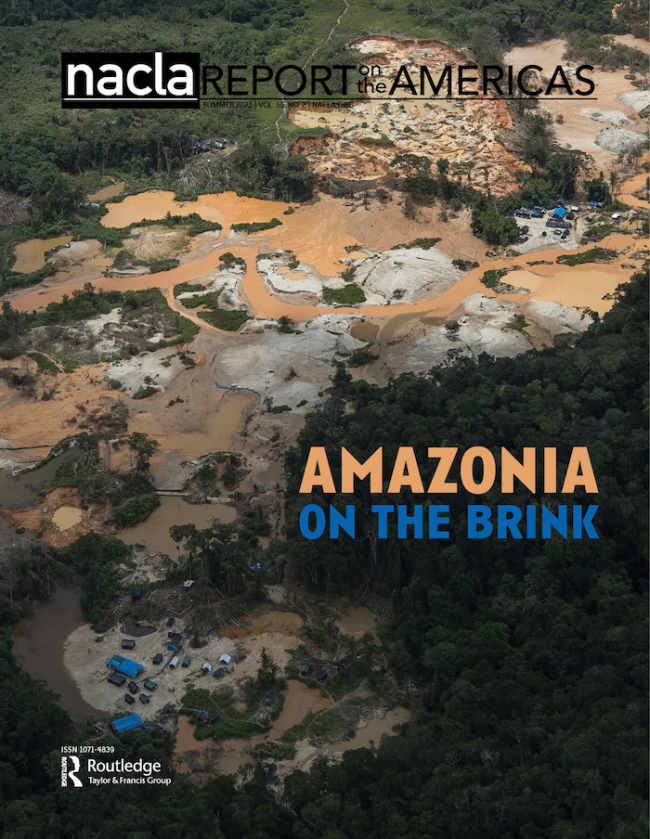
This piece appeared in the Summer 2023 issue of NACLA's quarterly print magazine, the NACLA Report. Subscribe in print today!
Leer este artículo en español.
The Amazon is the largest tropical forest in the world, and it is in danger of disappearing. Fires, sustained increases in deforestation rates, exploitation of natural resources, and construction of infrastructure projects are just some of the factors contributing to this phenomenon. As Indigenous and community leaders, climate activists, scientists, and academics declared in 2019 at an international gathering in the Brazilian state of Pará—organized by the Association of Residents of the Rio Iriri Extractive Reserve (Amoreri), Eliane Brum, the Ibirapitanga Institute, and the Socioenvironmental Institute—the Amazon is the center of the world. And, as the center, it deserves as much attention as possible.
This issue of the NACLA Report on the Americas brings together activists, researchers, and artists who work with and in the Amazon to explore the situation in the region, the challenges faced by its ecosystems and the people who live in them, and the possibilities of imagining a future in which the forest and its inhabitants are protected. As readers will see, the situation in the Amazon is multifaceted. The articles and conversations compiled in this issue thus offer a series of proposals for governments, civil society, and companies to build a better future, characterized by more just and equitable relationships between the land and its human and nonhuman inhabitants.
The Amazon is divided between nine South American countries: Bolivia, Brazil, Colombia, Ecuador, French Guiana, Guyana, Peru, Suriname, and Venezuela. However, comprehensive responses to the dangers the forest faces must go beyond political and administrative borders. Following this logic, actions to address the crisis in the Amazon must be co-created with the territory and those who live there.
This issue is grounded in conversations with and the thinking of Indigenous leaders from the Amazon who fight for the rights of their peoples and territories. Patricia Gualinga of the Sarayaku nation speaks in an interview with me about the Kawsak Sacha or Living Forests proposal, an integral mechanism that highlights the forest’s relationship with human and nonhuman beings. Alexandra Korap Munduruku of the Munduruku nation, who was recently awarded the 2023 Goldman Environmental Prize, speaks with Ana Carolina Alfinito about her fight against illegal mining in her people’s territory. In a piece edited and translated by Ana María Machado, artist and activist Ehuana Yaira Yanomami expresses the history and daily life of the Yanomami people and their actions to protect their territory in the face of constant threats from external actors.
Exploring the situation in Brazil, Raúl Silva Telles do Valle and Biviany Rojas Garzón take a wide-angle look at the challenges the inhabitants of the Amazon face and the possibilities for President Luiz Inácio Lula da Silva’s administration to intervene. For their part, Felipe Milanez and Roberto Araújo Santos recount the waves of violence and resistance in these territories. From a scientific perspective, Diego Oliveira Brandão, Julia Arieira, and Carlos Afonso Nobre detail the socioenvironmental challenges in the Amazon and offer a series of proposals to respond to the climate crisis, biodiversity loss, and threats to forest inhabitants. Offering similarly urgent proposals, Salo Coslovsky details the need to tap into global markets for Amazonian products that are socially and environmentally sustainable and that can serve as creative responses to the extractivist and predatory economies destroying the forest.
From Colombia, Rodrigo Botero García takes readers on a journey that shows the combination of public policies needed to respond to urgent issues such as deforestation, armed violence, and attacks on the inhabitants of the Amazon. From this same corner of the forest, Germán A. Palacio offers a critical look at the imaginaries constructed about the Amazon and the relationship of humans and nonhumans with this region.
Following these explorations, a final set of pieces invite us to turn our attention to issues that don’t always top the agenda in debates about the Amazon. Seth Garfield assesses U.S. relations vis-à-vis the Brazilian Amazon, which have taken shape around a tension between national sovereignty and foreign intervention. Adrián Lerner Patrón shifts the focus from the forest to cities, showing how growing urbanization in the Amazon represents political, social, and economic processes that we must grasp to understand the region’s past, present, and future. And José Octavio Orsag Molina analyzes Amazon historiographies, tracing long-running phenomena such as the idea of “development” and the exploitation of forest inhabitants. Finally, interspersed throughout this issue is the wonderful work of Silia Moan, whose artistic perspective offers a series of images about everyday life in the Amazon.
In closing, I would like to thank NACLA managing editor Heather Gies for her committed and careful work with each author in this issue and for generously inviting me to explore the situation of the Amazon with this group of contributors. Likewise, many thanks to each and every author who participated in this issue. Their voices and reflections are seeds that will bear fruit in defining the future of this region. We hope that this collective space will generate powerful conversations that will allow us to respond to the crisis today in the Amazon, the center of the world.
Translated from Spanish by NACLA.
Carlos Andrés Baquero Díaz is a JSD student at New York University. His research interests include environmental law, human rights, multiculturalism, and governance.
Cover photo by Bruno Kelly / Amazônia Real

